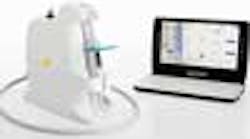Quantum Dental Technologies introduces caries detection device to USA dental market
TORONTO, Ontario, Canada--Quantum Dental Technologies, a Canadian diagnostic device company, plans to introduce The Canary System to U.S. dentists and hygienists at the 2013 Chicago Dental Society Midwinter Meeting.
The Canary System offers technology for evidence-based detection and monitoring of dental caries without the need for dental X-rays.
The system uses “Energy Conversion Technology,” a combination of photothermal radiometry and luminescence technology, to identify and measure tooth decay. This technology is directly linked to the status of the tooth’s crystal structure, not bacterial porphyrins.
The system’s handheld laser emits a low-power, pulsating light to collect unique signatures of luminescence and heat released from the tooth. This laser light interacts differently with healthy enamel than with decayed enamel, providing the dentist with a tool to identify carious lesions as deep as 5 mm below the tooth surface and as small as 50 microns in size.
According to Dr. Stephen Abrams, pesident and cofounder of Quantum, “The Canary System is the only caries detection device linked to the crystal structure of the tooth instead of the presence of bacteria, and is the only device that can detect decay on all tooth surfaces, including interproximal areas and around the margins of restorations or fillings. The Canary System detects and monitors caries across the entire spectrum of the disease process so it becomes an integral part of the preventive and restorative aspects of oral health care.”
The Canary System is noninvasive and helps preserve the integrity of the tooth and the entire dentition. It can detect caries in a number of clinical situations, including smooth enamel surfaces, root surfaces, occlusal surfaces, interproximal regions, around existing amalgam or composite fillings, and beneath dental sealants.
“We need to shift from a surgical approach to disease management and prevention,” said Abrams.
"If decay is identified, dentists can also place a restoration earlier than otherwise would have been found using conventional approaches, thus preventing more serious complications."
For more information, visit www.thecanarysystem.com.
To comment on this new product, go to http://community.pennwelldentalgroup.com.






